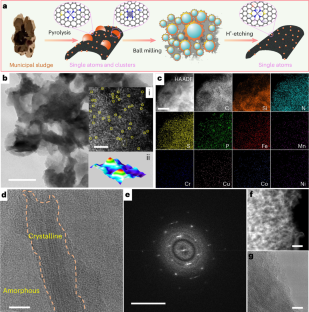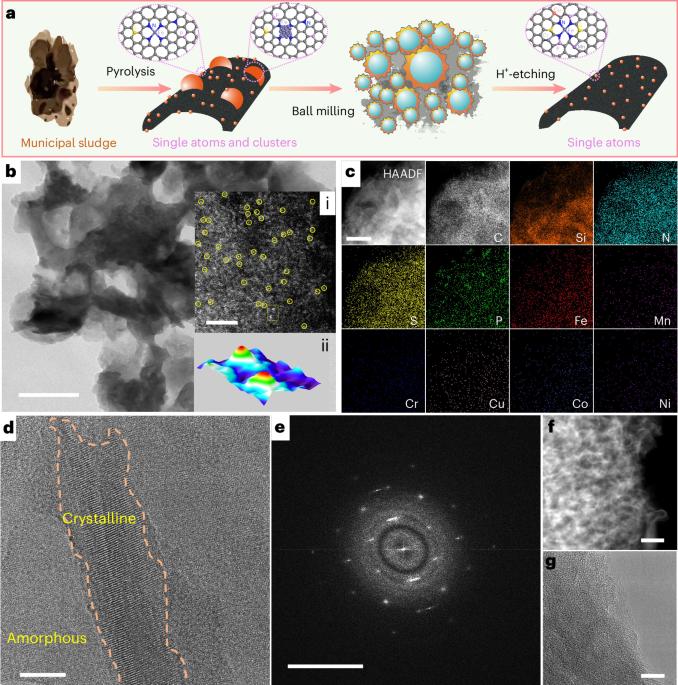Upcycling waste sewage sludge into superior single-atom Fenton-like catalyst for sustainable water purification
IF 24.1
引用次数: 0
Abstract
The worldwide generation of waste sludge emanating from municipal wastewater treatment plants amounts to 80–90 million tons of dry matter annually and continues to escalate, posing a substantial economic and environmental challenge for society. Although waste sludge offers a tantalizing resource to be harnessed, highly efficient and effective strategies for its repurposing remain elusive due to its complex compositions and low concentration of recoverable metallic elements. Here we devise a straightforward methodology for adept transformation of waste sludge into high-value single-atom catalysts (SACs) for water purification. This process involves in situ upcycling of trace redox-reactive transition metals present in sludge into single-atom speciation by carbon, nitrogen, sulfur, phosphorus, silicon and aluminium via the formation of reactive anchoring sites and selective chemical bonds. Sludge-derived SACs demonstrate remarkable reactivity, stability and selectivity in Fenton-like degradation of various contaminants. Structural analyses and density functional theory calculations reveal that co-coordinated iron single atoms act as the principal reactive sites in the catalysts. In addition, other single-atom transition metals with distinct coordination structures form and contribute to catalytic performance. Furthermore, we employ life cycle assessment and payback period analysis to conduct an evaluation of sludge upcycling to SACs with considerations of environmental impacts and production costs at an industrial level. Compared with conventional incineration, the overall life cycle impacts of our upcycling approach on human health, ecosystems and resources are much lower and exhibit a greater potential for reduction of emissions. This innovative technology promises financial benefits, obviates the substantial economic burdens of sludge disposal and charts a new trajectory for waste sludge disposal, promoting the genesis of more sustainable wastewater and waste management frameworks. The transformation of waste sludge from municipal wastewater treatment plants into valuable resources is fraught with challenges due to its complex composition. The approach proposed here efficiently upcycles trace redox-reactive transition metals present in sludge into single-atom catalysts, offering the dual benefit of effective sludge disposal and enhanced water purification.


将废弃的污水污泥升级改造成优异的单原子芬顿催化剂,实现可持续水净化
全世界每年从城市污水处理厂产生的废弃污泥达 8000 万至 9000 万吨干物质,而且还在不断增加,给社会带来了巨大的经济和环境挑战。尽管废弃污泥提供了一种诱人的可利用资源,但由于其成分复杂且可回收金属元素浓度低,高效且有效的污泥再利用战略仍难以实现。在此,我们设计了一种直接的方法,将废弃污泥巧妙地转化为用于水净化的高价值单原子催化剂(SAC)。这一过程包括通过形成活性锚定位点和选择性化学键,将污泥中存在的痕量氧化还原反应过渡金属就地提升为碳、氮、硫、磷、硅和铝等单原子规格。污泥衍生的 SAC 在芬顿样降解各种污染物的过程中表现出卓越的反应性、稳定性和选择性。结构分析和密度泛函理论计算显示,共配位铁单原子是催化剂的主要反应位点。此外,其他具有独特配位结构的单原子过渡金属也对催化性能有所贡献。此外,我们还采用了生命周期评估和投资回收期分析方法,对污泥升级再循环至 SAC 进行了评估,并考虑了工业层面的环境影响和生产成本。与传统的焚烧法相比,我们的升级再循环方法对人类健康、生态系统和资源的整体生命周期影响要低得多,并具有更大的减排潜力。这项创新技术有望带来经济效益,消除污泥处置带来的巨大经济负担,为废弃污泥处置开辟一条新的道路,促进建立更可持续的废水和废物管理框架。
本文章由计算机程序翻译,如有差异,请以英文原文为准。
求助全文
约1分钟内获得全文
求助全文
文献相关原料
公司名称
产品信息
阿拉丁
methyl phenyl sulfone
阿拉丁
methyl phenyl sulfoxide
阿拉丁
dimethyl sulfoxide
阿拉丁
benzoic acid
阿拉丁
methylene blue (MB)
阿拉丁
rhodamine B (RhB)
阿拉丁
ofloxacin (OFX)
阿拉丁
carbamazepine (CBZ)
阿拉丁
sulfanilamide
阿拉丁
sulfamerazine (SMZ)
阿拉丁
sulfamethoxazole (SMX)
阿拉丁
2,4,6-trichlorophenol (2,4,6-TCP)
阿拉丁
2,4-dichlorophenol (2,4-DCP)
阿拉丁
4-chlorophenol (4-CP)
阿拉丁
bisphenol A (BPA)
阿拉丁
phenol
阿拉丁
1,4-benzoquinone

 求助内容:
求助内容: 应助结果提醒方式:
应助结果提醒方式:


